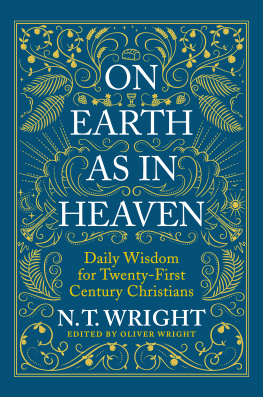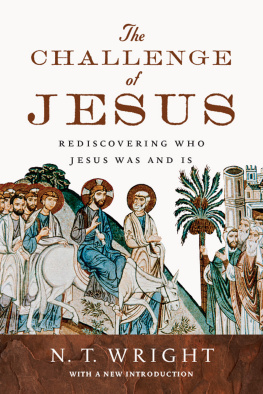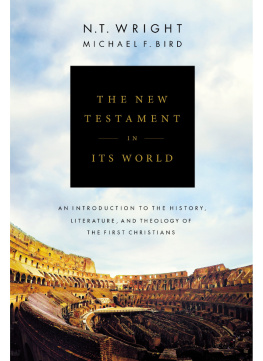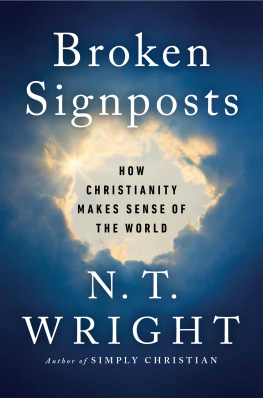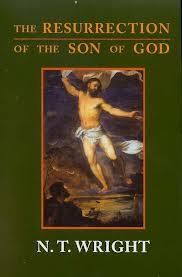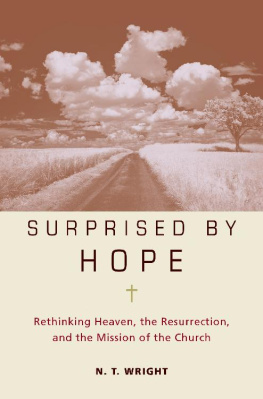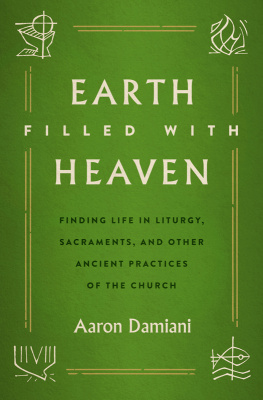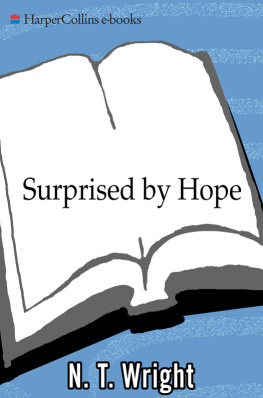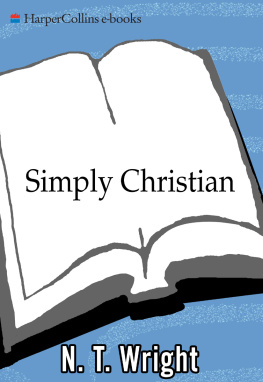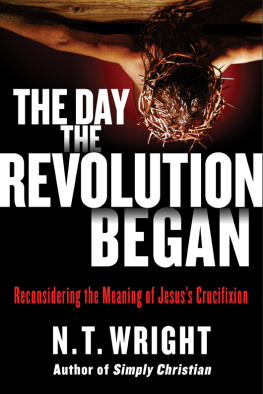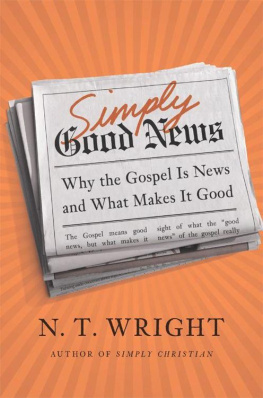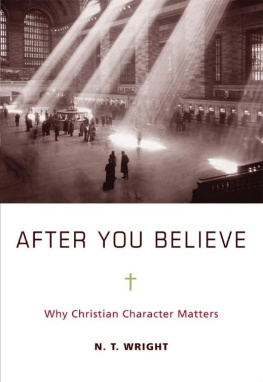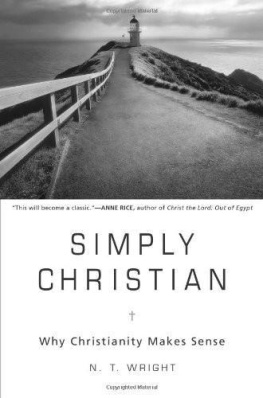Contents
Like time itself, certain ideas creep up on you and, before you know it, they have changed the way you think about everything else.
Thats how it was for me with the resurrection of Jesus. Brought up to go to church, to sing the hymns and say the prayers, I knew the story. On the third day he rose again and all that. But the sermons I heard and most of the hymns we sang around Eastertime were not actually about resurrection itself. They were about going to heaven. We assumed that talking about Jesuss resurrection was simply vivid picture language for saying that he was now alive, and that this meant that we, his followers, would go to heaven, to be with him in the end.
One of the regular Easter hymns said as much:
May we go where he is gone,
Rest and reign with him in heaven.
Adding Alleluia to that (as you do) simply reinforced that message: resurrection = life after death = going to heaven. End of story.
Except that it isnt. The last scene in the Bible isnt about saved souls going up to heaven. It is about the New Jerusalem coming down from heaven to earth as the centerpiece of the new heaven and new earth promised by the prophets and reaffirmed by Jesus himself and his first followers. That didnt fit the story line we had been taught. So most of us just treated it as a bit of flowery decoration around the edge.
But the more I tried to preach and teach the message of the New Testament in various church and university settings in the first twenty years or so of my public ministry (I was ordained in 1975), the more I came to realize that the old picture wouldnt do. In particular, I found myself trying to think through what the original gospel meant, first personally and pastorally and then with regard to culture and politics. And one day it dawned on me: I was glimpsing in a whole new way what Jesus meant when he taught us to pray that Gods kingdom would come on earth as in heaven.
Up till then, I had vaguely thought of this as a temporary measure. Until we go to heaven ourselves, it would be nice if earth (at least, our little bit of it) could be a bit more, well, heavenly. But that makes nonsense not only of the Lords Prayer, but also of Jesuss whole announcement of Gods kingdom. And, ultimately, of his death, through whichin his own teaching and in the eager and excited teaching of his first followersthat kingdom had been established, though not in the way anyone had imagined before.
At the heart of that new way was a new sense of time itself. The Jewish people, unlike most other ancient cultures, thought of time as a line. It had a beginning (creation), an end (when God would put the whole world right), and a middlethe confused and dangerous period they themselves were living in. But now, principally because of Jesuss resurrection, his followers came to believe that the end had already arrived, while the middle was still going on. Time itself got muddled upor, as they came to see it, time itself was redeemed, given back to us in a new mode. The prayer had been answered, in advance of the final putting right of all things. Gods new world had indeed begun, on earth as in heaven. Jesuss bodily resurrection from the dead was an event that so comprehensively shattered the normal patterns of this world that it launched nothing short of new creation.
The first Easter, then, was par excellence the event of Gods kingdom coming on earth as it is in heaven. As we pray every day for Gods kingdom to come, we are praying that we will be shaped more and more by that Easter reality, rather than by the prevailing and sometimes persuasive realities that the present world tries to offer us.
So how does this work?
When you get off the plane in a new time zone, you adjust your watch to the right time in the new location. One of the most striking things Jesuss first followers did was to adjust their watches to this belief that Gods ultimate future had arrived in the present.
They didnt, of course, have literal watches. But they measured time, as we still do, in seven-day weeks, and they made a radical change in how they marked those weeks. For the Jewish people, the sabbath at the end of the week functions as a forward signpost to Gods ultimate new world. The early Christians, however, changed thatand if you know anything about traditional societies, you will see what a dramatic thing this was to do. They met for worship on the first day of every week. And they did so because they believed that with Jesuss resurrection Gods new world had already begun. They were living in a new time zone, with new possibilities, challenges, encouragements, and obligations. They had to adjust their sense of time itself.
Within two or three generations, this sense of living in a new time zone developed its own new styles of annual celebration. An annual cycle, focused on Jesuss death and particularly his resurrection, became a way of telling the all-important story of those events, not just in words but in acted-out drama. The whole point was, and is, that these events are not simply things to think about, though, of course, they are that as well. They form a story within which we are called to live, a play in which we discover ourselves already on stage, trying to learn our lines even as the drama unfolds. The putting right of all creation has begun. Jesuss people, themselves having been put right, are to live as signposts to Gods final new creation. Thus, to celebrate Easter itself and to highlight it in the way we organize the whole year, weaving it into our collective consciousness, is to plant the truth of the gospel deeply into our imaginations and assumptions.
The world, of course, will shriek that this is all fantasy. Horrors and disasters fill our newspapers and televisions screens. Murder, disease, violence, and oppression continue as before. But the early Christians show us the way. They knew, better than most of us, that idolatry and injustice are still powerful. But they celebrated the new day, the new time, the new Easter reality, the new Easter and Pentecost reality.
And, despite the chorus of skepticism, the world really has changed. It is still changing. Gods kingdom is coming on earth as in heavenin the ways Jesus said it would, through the pure in heart, the meek, the mourners, the people hungry for justice, and so on. And these changes are signposts to the ultimate transformation, when Jesus comes again to implement fully and finally the victory he won on the cross, the victory whose most stunning immediate result was his own resurrection. In the meantime, millions of Jesuss followers find, year by year and season by season, that telling and living the great story, as an annual cycle whose launch and whose climax is Easter itself, is a great way of keeping ourselves oriented to Gods time, of keeping our heads and our hearts in the right time zone.
This present book is, on one level, a collection of short passages taken from several of my books. They have been organized so that readers are encouraged to reflect more deeply on what Gods kingdom coming on earth as in heaven might look likewhen seen through the lens of Easter itself. The truth of Jesuss resurrection is the starting point for every day, week, month, and year of Christian living. It is in the resurrection that we find our hope, our mission, and our love. It is the event above all that calls us to worship God the creator, the life-giver. So, quite deliberately, this book does not run from January 1 to December 31. It begins with the first day of new creation, Easter Day; it ends with a second Easter, coming full circle, always with the Easter invitation to begin again.
The kingdom coming on earth as in heaven thus invites those of us who pray these words into a new experience of time. In several churches, including the Anglican Church, which has been my home throughout my life, the churchs calendar provides a rich, subtle, and powerful way of making the gospel our own. This book follows that calendar, taking us through seven feasts and fasts in the Christian calendar, Easter, Ascension, Pentecost, Advent, Christmas, Lent, Passiontide, and returning at last to Easter again. (Easter is, of course, a moveable feast. Those who use this book in any given year are encouraged to make any necessary adjustments, to stretch or shrink the selections to fit.)

